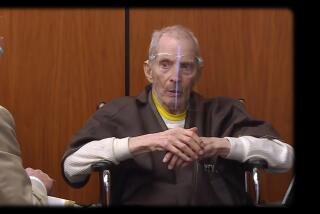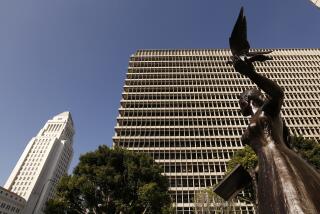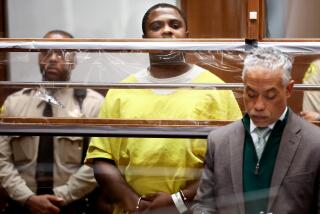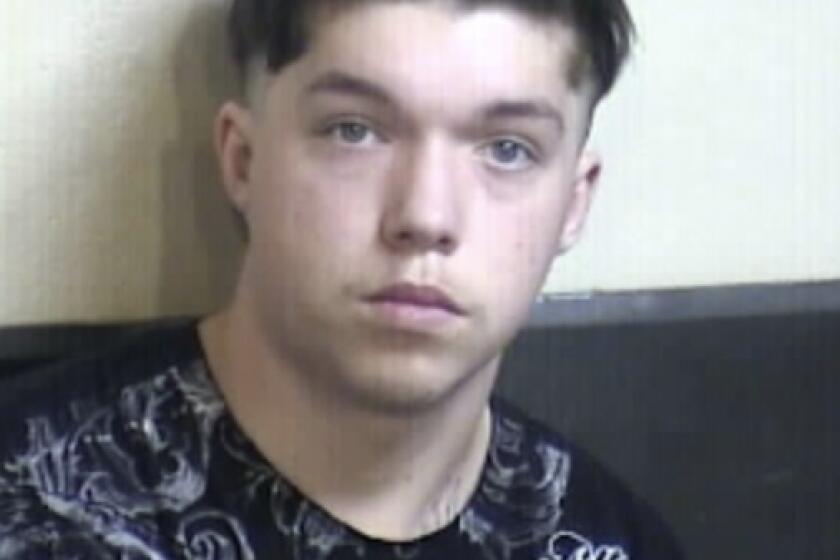Robert Durst, charged with murdering writer, faces new weapons charges
Hours after Los Angeles County prosecutors filed a murder charge against real estate scion Robert Durst in the December 2000 killing of his longtime friend Susan Berman, who was found shot execution-style in her Benedict Canyon home on Christmas Eve, Louisiana officials rebooked him on new weapons charges.
In L.A., Durst, 71, is accused of lying in wait and killing a witness -- accusations that would make him eligible for the death penalty if convicted.
Louisiana law enforcement officials announced late Monday that Durst has been booked on two new weapons-related charges: convicted felon in possession of a firearm and possession of a weapon with a controlled dangerous substance. The substance was a small amount of marijuana, Louisiana State Police spokeswoman Melissa Matey said.
Durst was taken into custody in New Orleans this weekend at the behest of Los Angeles officials, who say they have uncovered new evidence linking him to Berman’s slaying. New York authorities had been planning to interview Berman about what she knew about the 1982 disappearance of Durst’s first wife, Kathleen.
On Monday, two sources familiar with the investigation said prosecutors believe Durst shot Berman in the head to prevent her from cooperating with that investigation, spearheaded by Jeanine Pirro, who was then district attorney for Westchester County, N.Y.
The murder charge follows an HBO documentary series, “The Jinx,” on the eccentric Durst and his possible ties to several deaths. In the closing scene of the six-part documentary, Durst, speaking into a microphone he may not have known was on, muttered: “Killed them all, of course.”
It was the latest turn in a whirlwind 48 hours for Durst, who went from the subject of a stranger-than-fiction documentary about his life to being the target of a prosecution that he may have initiated by choosing to speak to documentary filmmakers.
Durst had beaten murder charges in Texas in 2003, arguing that he cut up the body of a friend after the man was killed during a struggle over a loaded gun. His lawyers successfully argued that Durst had acted in self-defense.
His latest arrest came one day before the finale of the HBO series aired. In the closing scene of the documentary, Durst made a series of comments some heard as confessional. “You’re caught,” he mumbled, after a tense interview about his possible involvement in Berman’s death.
During a brief court hearing in New Orleans on Monday morning, Durst did not challenge his extradition to Los Angeles.
Sitting shackled in a glassed-in cell apart from other inmates, Durst periodically scrutinized the throng of media in the courtroom gallery, closing his eyes to rest before being led out of the cell by sheriff’s deputies.
Asked by Orleans Parish Magistrate Judge Harry Cantrell Jr. if he waived his right to extradition to California, Durst faced the judge and said “Yes, I signed it, your honor.”
His actual extradition, however, may not be so simple. One of Durst’s attorneys, Chip Lewis of Houston, said Durst may face a marijuana possession charge based on items recovered from his hotel room when he was arrested.
Timeline: The twists and turns of Robert Durst
Lewis confirmed that Durst would not be leaving New Orleans on Monday. Matey said she did not know whether prosecutors in Louisiana would try to keep Durst on the new charges there before sending him to Los Angeles.
Durst was in possession of a revolver when FBI agents arrested him Saturday, according to court documents, which also said he was considered a flight risk and classified as “armed and dangerous.”
Law enforcement sources told the Los Angeles Times that authorities believed Durst might attempt to flee after it became obvious that the investigation had picked up steam last week as “The Jinx” neared its conclusion.
But Lewis said Durst left Houston for New Orleans because he was being besieged by media because of the documentary. Durst wasn’t hiding out, Lewis added, and had been in New Orleans for a week.
Lewis earlier said Durst surrendered without incident to FBI agents at the JW Marriott hotel.
Durst stayed in Room 2303, and Lewis said he would call to check in daily, asking for him by name.
“He was just hanging out, enjoying New Orleans,” Lewis said. “He’s a guy from the hippie generation.”
Lewis had suggested Durst go to New York or Los Angeles.
“Those are the last two places I want to go,” he replied.
Durst traveled to New Orleans once before in the face of possible prosecution. After he was arrested in the murder and dismemberment of a neighbor while living in Galveston, Texas, Durst posted a $300,000 bond and disappeared into Louisiana, according to Julie Smith, a New Orleans novelist and close friend of Berman.
Smith told the Los Angeles Times that Durst rented an apartment in New Orleans under the alias Diana Wynn and disguised himself as a woman. It was the same tactic she said he used to keep anyone from tracking him down in Galveston when he moved there in 2000, after prosecutors in New York reopened the inquiry into his wife’s disappearance.
Smith, who has published more than 20 novels, said she met Durst on several occasions and described him as “withdrawn” and “antisocial.”
Berman once discussed Kathleen Durst’s disappearance with Smith but warned her not to write about the case.
“It was like, ‘Bobby would hurt you,’” Smith told The Times. “It was not explicit, but it was clear that’s what she meant.”
Smith said she always believed Durst was responsible for her friend’s death.
“Do I think he killed Susan? Sure. I used to never answer that. I’d say no, I don’t know -- because he’s so dangerous,” she said. “Now I can, because he’s in custody and I don’t think he’s getting out.”
In Sunday evening’s HBO episode, Durst left his final interview with filmmaker Andrew Jarecki to use the bathroom, appearing not to notice that his microphone was still recording as he muttered to himself, “What the hell did I do? Killed them all, of course.”
“There it is, you’re caught,” he said to himself in another moment. “What a disaster.”
Legal experts believe Durst’s stream-of-consciousness ramblings would be admissible in court, as the 71-year-old agreed that statements he made during the filming process could be used in the final version of the film.
“There are prohibitions against government eavesdropping and there are prohibitions against listening in on confidential conversations, all those are neatly established,” said Stanley Goldman, a Loyola law school professor and expert on criminal procedure and evidence issues. “There’s no muttering to yourself in the men’s room exception.”
Peter Arenella, a UCLA law professor and nationally recognized expert on criminal law, said because it was a private party -- the documentary crew -- rather than police who recorded Durst, his attorneys would not be able to invoke his 4th Amendment right against unreasonable search and seizures.
Defense attorneys could try to argue the documentarians began working with law enforcement and became agents of the government, he said. But Arenella added that such an argument would be a longshot.
Defense attorneys, however, could argue that there is almost no way to prove Durst’s mumbling qualifies as a confession.
“It could’ve meant almost anything,” said Harvard law professor Noah Feldman. “When you’re talking to another person, you’re communicating something. When you’re talking to yourself, it could be speculation, trying something out for size. Whatever it is, it’s not obviously a recitation of facts.”
Despite the chilling remarks made during the HBO series and various pieces of information collected by the filmmakers, top LAPD officials said Monday they did not believe the documentary was connected to the decision to arrest Durst.
“We based our actions on the investigation and the evidence,” LAPD Deputy Chief Kirk Albanese said. “We didn’t base anything we did on the HBO series. The arrest was made as a result of the investigative efforts and at a time that we believe it was needed.”
A source who requested anonymity because of the ongoing investigation, previously told The Times that the documentary had played a role in Durst’s arrest. In a statement released Sunday, the LAPD said only that Durst’s arrest in Berman’s slaying was the “result of investigative leads and additional evidence that has come to light in the past year.”
Durst had agreed to lengthy interviews for the HBO series and spoke about Berman, who was shot execution-style in her Benedict Canyon home just as New York authorities were preparing to interview her about the 1982 disappearance of Durst’s first wife.
Three times, people close to Durst have vanished or been killed. He has been a suspect, person of interest or defendant in those cases, each time confounding authorities as they have tried and failed and tried again to build murder cases against him.
Richard DeGuerin, a renowned criminal attorney who defended Durst in a previous murder case and said he would mount his defense again, lashed out at the arrest, saying he believed it was timed to correspond with the last installment of HBO’s documentary Sunday night.
“Do I think this is a coincidence? Hell, no,” DeGuerin told The Times as he prepared to board a plane for New Orleans on Sunday. “There has been rumor, innuendo and speculation for a number of years, and now we’re going to get our day in court on this.”
On Christmas Eve 2000, Berman’s body, with a single gunshot wound to the head, was found by police in her small home. She lived alone, and police were alerted only after neighbors spotted one of her dogs running loose and her door open. At the time, police said they believed she may have been killed a few days earlier, that nothing appeared to be missing from her home and that the assailant entered without signs of a struggle.
At the time of her death, authorities in New York were trying to talk to the L.A. writer about the disappearance of Durst’s wife.
In the fifth episode of the documentary, investigators said they had always suspected Durst in Berman’s slaying, but could not prove he was in Los Angeles at the time of her death. Durst told filmmakers that he was in California at the time, and records obtained by the filmmakers showed he was in Trinidad, Calif. -- nearly 700 miles north of L.A. -- days before Berman was shot.
The documentary also showed Durst flew from San Francisco to New York shortly after the shooting.
The central piece of information recovered during the documentary seemed to be an envelope, discovered by Berman’s stepson during filming, that was eerily similar to a so-called cadaver note sent to the Beverly Hills Police Department after Berman’s death.
The note, which contained only Berman’s address and the word “cadaver,” was written in similar fashion to a piece of mail written on letterhead from Durst’s Wall Street offices. In the series finale of “The Jinx,” a forensic analyst said the handwriting styles appeared similar. Both also had a similar spelling error, with the word Beverly written as Beverley.
A law enforcement source familiar with the cold-case investigation said that the Los Angeles County district attorney’s office reviewed the case against Durst several years ago but decided against filing charges. Among their concerns was that investigators could not prove that Durst was in Los Angeles around the time of the killing.
A separate law enforcement source told The Times that during the previous review of the case, police also struggled to connect Durst to the murder weapon. A previous forensic examination of the cadaver note was also inconclusive.
Both sources requested anonymity because the case was ongoing.
In 1982, Kathleen Durst vanished shortly after she began talking about her desire to get a divorce from her husband. She had been fighting with her husband the night she disappeared, according to a good friend, who said Durst was worried about what her husband might do to her.
Berman acted as an “informal spokesman” for Durst, calling to give his side of the story to media outlets and people who suspected that he had a role in his wife’s disappearance. Durst and Berman went to school together at UCLA.
Less than a year after Berman died, garbage bags with dismembered body parts of Durst’s neighbor were found floating in the water off Galveston, Texas. A receipt in one of the bags and a bloody trail to his apartment led to Durst being charged with murder.
Durst quickly posted bail and, according to police, went on the lam. He was arrested soon after in a Pennsylvania grocery store, where police said he was caught shoplifting a chicken sandwich and a bandage, despite having $500 with him. Durst was returned to Texas, where he admitted to shooting and dismembering neighbor Morris Black, but claimed he inadvertently shot Black while struggling to wrestle a gun away from the man.
The 2003 trial was a spectacle in which his attorneys argued that after the killing a previously undiagnosed mental condition had propelled Durst into a traumatized state similar to an out-of-body experience. The trial was capped by four days of testimony by Durst in which he claimed he had no memory of cutting up Black’s body.
On Monday in New Orleans, employees at a coffee shop near the hotel where Durst was staying said they had served the quiet, elderly man almost daily in the last week, but had no idea who he was.
“Every morning he does the same thing: a small coffee and sit at the corner table,” said Brittany Harris, a 20-year-old barista at PJ’s coffee shop.
Durst always paid cash for his morning coffee, and offered a $5 tip with each order, said Harris and another barista, 41-year-old Kim Davis.
Both had seen advertisements for the “Jinx” documentary series, but neither connected the wiry figure in their coffee shop to the man linked to a trio of deaths and disappearances.
“He never looked tired or restless. that’s why it’s so shocking,” Davis said. “He showed no signs.”
Times staff writers Kate Mather and Victoria Kim contributed to this report. Hennessy-Fiske reported from New Orleans. Winton and Queally reported from Los Angeles.
Twitter: @mollyhf, @lacrimes, @JamesQueallyLAT
MORE:
Key characters you should know about
Timeline: The twists and turns of Robert Durst
Robert Durst: Decades of deaths and suspicions
More to Read
Sign up for Essential California
The most important California stories and recommendations in your inbox every morning.
You may occasionally receive promotional content from the Los Angeles Times.









